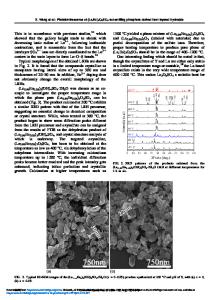Synthesis and luminescent properties of a novel red emitting La 2 Mo 3 O 12 : Li + , Eu 3+ phosphor
- PDF / 3,184,060 Bytes
- 6 Pages / 595.276 x 790.866 pts Page_size
- 39 Downloads / 293 Views
Synthesis and luminescent properties of a novel red emitting La2Mo3O12: Li+, Eu3+ phosphor Chao Song1 · Qiang Ren1 · Juhong Miao1 · Qiling Hong1 · Weifeng Rao1 Received: 20 February 2018 / Accepted: 9 April 2018 © Springer Science+Business Media, LLC, part of Springer Nature 2018
Abstract La2Mo3O12: Eu3+ (5 mol%) red phosphors co-doped with different concentrations of Li+ ions have been synthesized by a citric acid based sol–gel method. X-ray powder diffraction, field emission scanning electron microscope, photoluminescence (PL) spectra and luminescence decay kinetics were used to characterize the synthesized samples. The results show that the excitation spectra of L a2Mo3O12: Li+, Eu3+ phosphors consist of a broad and strong absorption band in the ultraviolet (UV) and near ultraviolet (NUV) regions, which can be efficiently excited by the NUV light. The emission spectra of the phosphors exhibit characteristic luminescence 5D0→7FJ (J = 1, 2, 3, 4) of the E u3+ ions with a dominant electronic transition located at 5 7 + 3+ 615 nm ( D0→ F2). Incorporation of L i ions in L a2Mo3O12: Eu lattice can induce a remarkable improvement of their PL intensity and the optimal concentration of Li+ is 15 mol%. Furthermore, the estimated chromaticity coordinate about (0.65, 0.34) is very close to the ideal red light (0.670, 0.330). These results indicate that the Li+ doped La2Mo3O12: Eu3+ phosphors can serve as NUV excited red phosphors for white light emitting diodes.
1 Introduction White light emitting diodes (LEDs) have attracted much attention due to their high luminous efficiency, energy saving, long lifetime, and environmental friendliness [1–3]. The most mature method for fabricating commercial white LEDs is using a blue diode chip combined with Y 3Al5O12: Ce3+ 3+ (YAG: Ce ) yellow phosphors. However, it has some drawbacks such as low color rendering index and high correlated color temperature due to the lack of red light component [4, 5]. White LEDs can also be made by combining a near ultraviolet (NUV) chip with a mixture of high-efficiency red-, green- and blue-emitting phosphors [6, 7]. Using this approach, the color temperatures and color rendering index of the white LEDs can be designed flexibly, since the color is controlled solely by the three phosphors. Currently, Y2O2S: Eu3+, ZnS: (Cu+, Al3+), and B aMgAl10O17: Eu2+ are utilized as red-, green- and blue-emitting phosphors for white LEDs * Juhong Miao [email protected] 1
Department of Materials Physics, IEMM, and Jiangsu Key Laboratory for Optoelectronic Detection of Atmosphere and Ocean, Nanjing University of Information Science and Technology, Nanjing 210044, People’s Republic of China
based on the NUV chip [6]. Unfortunately, the luminescence efficiency of Y 2O2S: Eu3+ is quite lower than that of the blue and green-emitting phosphors [8]. Furthermore, sulfide phosphors are chemically unstable and show luminescence saturation with increasing current when incorporated into white LEDs. So there is an urgent need to develop
Data Loading...











